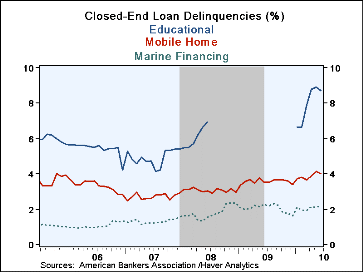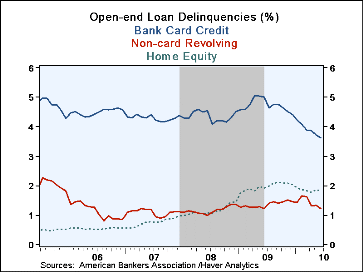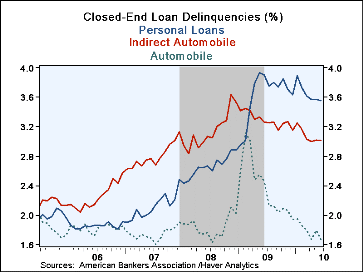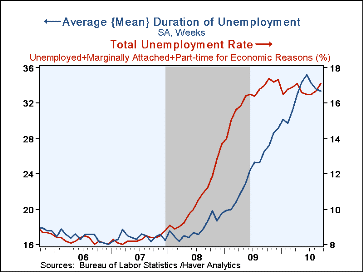 Global| Oct 20 2010
Global| Oct 20 2010U.S. Consumer Credit Delinquencies Have Fallen Somewhat
by:Tom Moeller
|in:Economy in Brief
Summary
Recent trends can be encouraging, but delinquency levels are less heartening. That is the message the American Bankers Association data which indicates that loan delinquencies across all types of credit recently have fallen. That may [...]
Recent trends can be encouraging, but delinquency levels are less heartening. That is the message the American Bankers Association data which indicates that loan delinquencies across all types of credit recently have fallen. That may be the expected effect with the emergence of the economy from recession. (Now comes the big however.) However, as the accompanying charts and table indicate, the declines have been modest and leave delinquencies still quite high.
Amongst open-end loans, the decline in bank-card
delinquencies has been most dramatic. At 3.63% of loans outstanding, the
rate has fallen more than one percentage point from its high. The decline
no doubt reflects consumers' conscious effort to reduce debt levels. Other
open-end bank loans such as home equity and non-card revolving financing
also have shown a similar, but relatively modest, decline.
The decline
no doubt reflects consumers' conscious effort to reduce debt levels. Other
open-end bank loans such as home equity and non-card revolving financing
also have shown a similar, but relatively modest, decline.
By-and-large, delinquency rates on closed-end loans remain high. Here, the effects of a total unemployment rate near 17% and a median duration of unemployment at roughly 34 weeks are at work. The most disturbing increase may be the surge in delinquencies on personal loans. Its recent decline to 3.6% still leaves it up from under 2.0% as recently as 2007. Making home equity loan payments also has proved difficult. The delinquency rate of 4.0% is nearly double that of late-2006, a clear reflection of loan values exceeding property valuations. And then there's the doubling of educational loan delinquencies to 8.7%. The unemployment for individuals with a bachelors degree or higher has more-than-doubled to 4.4%. Elsewhere, the decline of automobile loan delinquencies may reflect a switch to leasing. The drop in property improvement delinquencies may just reflect a drying up of the business.
The delinquency rate figures can be found in Haver's DLINQ database.
Underwater Mortgages from the Federal Reserve Bank of San Francisco is available here.
| Consumer Credit Delinquency Rate (%) | September | August | 2009 | 2008 | 2007 |
|---|---|---|---|---|---|
| Open-end Loans | |||||
| Bank Cards | 3.62 | 3.72 | 4.39 | 4.52 | 4.38 |
| Non-card Revolving | 1.21 | 1.33 | 1.46 | 1.35 | 1.12 |
| Home Equity | 1.81 | 1.84 | 2.04 | 1.46 | 0.96 |
| Closed-end Loans | |||||
| Home Equity | 3.97 | 3.94 | 4.32 | 3.03 | 2.39 |
| Property Improvement | 1.35 | 1.32 | 1.63 | 1.75 | 1.81 |
| Educational * | 8.69 | 8.91 | -- | -- | 5.39 |
| Mobile Home | 4.01 | 4.11 | 3.41 | 2.96 | 2.92 |
| Marine | 2.20 | 2.12 | 1.63 | 2.35 | 1.57 |
| Personal | 3.55 | 3.57 | 3.63 | 2.88 | 2.48 |
| Indirect Auto ** | 3.01 | 3.02 | 3.15 | 3.53 | 3.13 |
| Direct Auto | 1.67 | 1.79 | 1.94 | 2.03 | 1.90 |
* Break in data series in 2008 & 2009
** A direct loan is a loan directly from the bank to the customer. An indirect loan is a loan that is given to the customer from the dealership who then has to go through a bank.
Tom Moeller
AuthorMore in Author Profile »Prior to joining Haver Analytics in 2000, Mr. Moeller worked as the Economist at Chancellor Capital Management from 1985 to 1999. There, he developed comprehensive economic forecasts and interpreted economic data for equity and fixed income portfolio managers. Also at Chancellor, Mr. Moeller worked as an equity analyst and was responsible for researching and rating companies in the economically sensitive automobile and housing industries for investment in Chancellor’s equity portfolio. Prior to joining Chancellor, Mr. Moeller was an Economist at Citibank from 1979 to 1984. He also analyzed pricing behavior in the metals industry for the Council on Wage and Price Stability in Washington, D.C. In 1999, Mr. Moeller received the award for most accurate forecast from the Forecasters' Club of New York. From 1990 to 1992 he was President of the New York Association for Business Economists. Mr. Moeller earned an M.B.A. in Finance from Fordham University, where he graduated in 1987. He holds a Bachelor of Arts in Economics from George Washington University.










